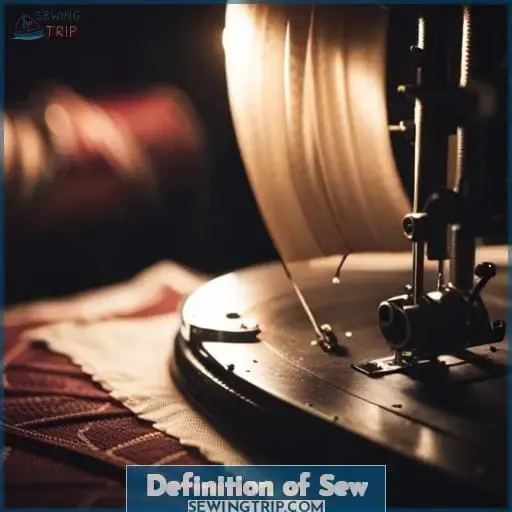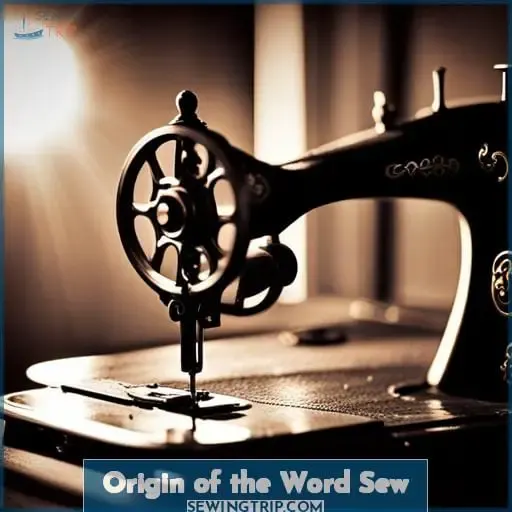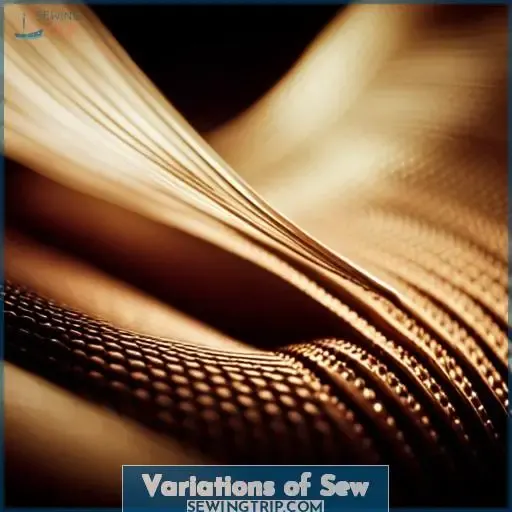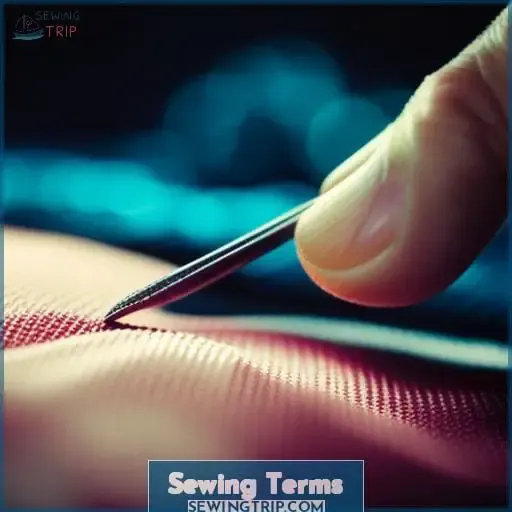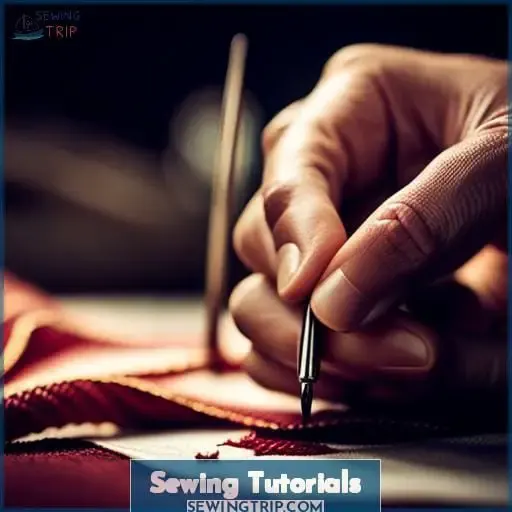This site is supported by our readers. We may earn a commission, at no cost to you, if you purchase through links.
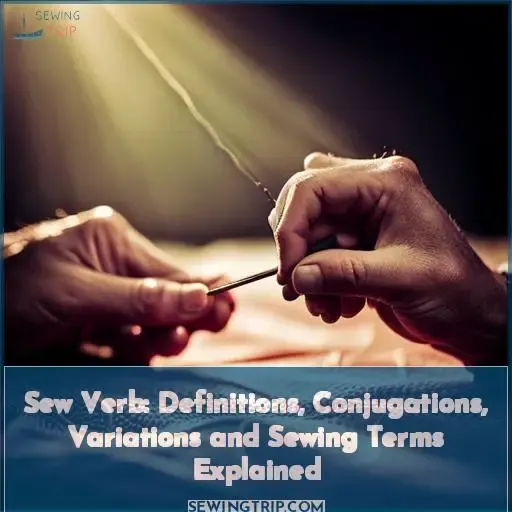 As you traverse the winding path of sewing, you’ll encounter the bend of the verb sew itself.
As you traverse the winding path of sewing, you’ll encounter the bend of the verb sew itself.
Its twisted etymology stitches together cognates from Sanskrit to Latin, as we’ll explore.
Through conjugations, variations, and essential terms, we’ll master this stitch in the linguistic fabric.
So prick up your ears and let’s plunge the needle of understanding into sewing’s verbal bedrock, towards liberation in its mastery.
Table Of Contents
Key Takeaways
- Sew has ancient linguistic origins, derived from Old English and Proto-Germanic ancestral words
- Cultural differences lead to variations in sewing terminology between British and American English
- Basic sewing stitches can become more complex techniques like embroidery and quilting
- As technology changes, traditional sewing terms endure over time
Definition of Sew
When using the verb sew, one must understand its various meanings.
The primary definitions relate to joining fabrics using a needle and thread.
Secondary meanings refer to fastening or enclosing objects with stitches.
Usage can also take on an informal sense, meaning to gain exclusive control or monopoly over something.
Meanings
When you’re looking at the verb sew, one of the first things to understand is its different meanings.
Creative stitches join fabrics, repair tears, and even enclose edges artistically.
Whether following patterns or improvising unique DIY projects, the sewing community shares a passion for needle and thread.
Basic stitches become embroidery, quilting, soft sculptures – textile arts liberate us to master fabrics as canvases for self-expression.
Even sewing terms convey the creativity stitching unleashes in those feeling thread’s call.
Usage
You’d hand-sewn and finished with beech wood legs, before this desk chair gets as classy as it can be.
In myth, ancient gods could stitch parts of different animals together to get a magical creature.
Over a hundred volunteers sewed panels that will ultimately be stitched into a tapestry.
She cuts up wool sweaters and sews them together in various combinations on a machine her mother gave her.
Origin of the Word Sew
Here we explore the origin of the word sew.
Language, like life, evolves over time.
Tracing a word’s etymology allows us to stitch together its lineage.
The verb sew has Old English origins, derived from the Proto-Germanic word siwjan.
It shares ancestry with similar words across related languages like Old Norse, Gothic, and Old High German.
The Proto-Indo-European root siū meant to sew and spawned descended words as languages branched out.
Through sound shifts and mutations, siū became sēowan in Old English by the 5th century CE.
The story of sew illustrates the fluid, living nature of language.
We inherit words from the past which get reworked and transformed as languages develop their own grammar and phonology.
Examining a word’s etymology reveals fascinating connections across time and cultures.
Variations of Sew
You’ll now find we briefly touch on variations of the verb sew.
Specifically, we’ll look at British English usages and other definitions.
This initiates discussion on flexible applications of the core term.
British English
Your understanding of British definitions for sew reveals subtle differences from American usage.
The history of sewing in Britain, influenced by generations of artisans, has led to linguistic variations in verb forms like sew up.
Appreciating cultural distinctions expands perspectives, bringing depth to everyday words.
Even as technology evolves, traditional terms endure, stitching languages together across borders with the common thread of craft.
Other Usages
Let’s move on to some key sewing terms you’ll need to know:
Stitch: A single unit of sewing, made by passing a thread through fabric and pulling it tight.
Thread: A thin, strong cord used for sewing.
Needle: A thin, sharp object with a hole at one end, used for sewing.
Fabric: A material made from fibers, used for clothing, upholstery, and other purposes.
Sew: To join pieces of fabric together with stitches.
Hand sewing: Sewing done by hand, using a needle and thread.
Machine sewing: Sewing done using a sewing machine.
Sewing Terms
Let’s now turn our attention to some key sewing terms that utilize the verb sew in interesting ways.
We’ll examine techniques, tools, and other concepts central to sewing and garment construction.
This exploration will shed light on the flexibility and nuance of sew when applied in specialized contexts.
Techniques
You’re often using various sewing techniques when constructing garments and projects.
Common techniques like applique, binding, easing, and draping allow you to shape fabric creatively.
Mastering both hand and machine techniques expands your abilities.
Simple tools like needles, thread, and fabric scissors enable intricate techniques.
With practice, essential sewing skills become second nature.
Tools
-
Sewing machine:
- Choose a basic mechanical or computerized model to start.
- Look for easy threading and button controls.
-
Hand-sewing needles:
- Stock different sizes like sharps for wovens and ballpoints for knits.
-
Scissors and rotary cutters:
- Invest in the best quality you can.
- Sharp cutting tools make sewing much easier.
Sewing Tutorials
When learning to sew, proper garment construction, and selection of fabrics and notions are paramount.
As an aspiring seamstress, you must comprehend techniques for constructing quality garments and utilizing appropriate tools and materials.
We’ll explain essential methods for sewing garments, from layout and cutting to stitching and finishing, ensuring durability and style.
Garment Construction
Your ease allowance provides room in the pattern for comfort and style over precisely matching body measurements.
To create a well-constructed garment, it’s important to understand various techniques:
- Dart shaping: Technique used to shape fabric around curves or seams.
- Edge stitching: Straight stitching close to edges for clean finishes.
- Embellishment: Decorative techniques like embroidery or appliqué.
Paying attention to garment drape ensures that your finished piece hangs beautifully on the body.
Mastering these skills will bring you closer to achieving liberation through sewing mastery.
Fabric and Notions
You’ll often select your fabrics and notions before starting a sewing project.
Notion Essentials
Color Combinations
Frequently Asked Questions (FAQs)
What are some common sewing mistakes for beginners to avoid?
When starting out, concentrate on learning:
- Proper threading
- Tension
- Seam finishes
- Pressing techniques
Rushing leads to frustration; take your time to build foundational skills.
Don’t worry about perfection, simply enjoy the process and creative potential of sewing.
How do I choose the right needle and thread for a sewing project?
Choosing needles and thread starts with understanding the project’s fabric type.
Match weight; heavier fabrics take thicker threads and needles.
Consider fiber content too – natural fibers often need sharper needles to pierce efficiently.
Do test stitches first, adjusting tension so the thread glides smoothly without bunching or skipping.
What sewing machine features are best for clothing construction versus craft sewing?
For clothing construction, focus on:
- Precise straight stitching
- Adjustable presser foot pressure
For crafts, prioritize:
- Convenient stitch selection
- Embroidery attachments
Carefully assess your needs before purchasing to get the right features without overspending.
How can I improve my free-motion sewing skills?
Stay focused.
Learn proper technique, then practice often.
Adjust machine tension and speed for control.
Move the fabric intentionally to create the desired design.
Be patient with yourself through mistakes; free motion sewing requires time to master.
Most importantly, have fun unleashing your creativity.
What tips help reduce back and neck strain when sewing for long periods?
To conquer the sewing marathon, transform your posture into a graceful dance:
Shoulders back,
Spine straight,
Head held high.
No more hunched backs or stiff necks shall hinder your creative flow.
Conclusion
As the old adage goes, A stitch in time saves nine.
Through this exploration of sew’s origins, conjugations, variations, and essential terms, you now grasp this stitch in the linguistic fabric.
Let the needle of understanding plunge deeper as you apply your newfound mastery of sewing’s verbal bedrock in creative ways, liberating imagination with each practicing prick and pull.

